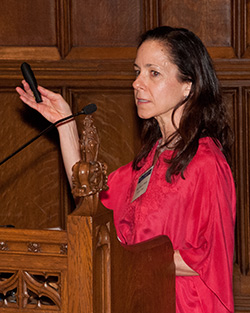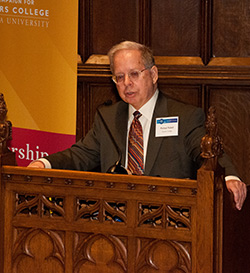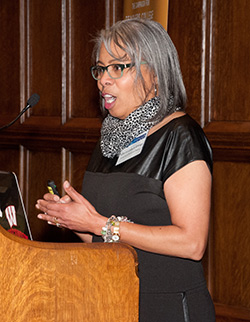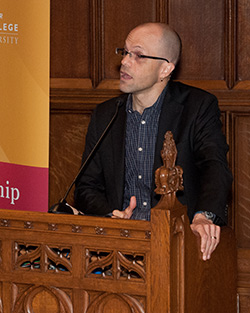Brown at 60: Segregation's Suburban Legacy
If you think school segregation ended in 1954 with the Supreme Court’s decision in Brown v. Board of Education, look no further than Nassau County, Long Island, to learn otherwise.
Nassau County’s non-Hispanic white population share declined from 92 percent in 1980 to 69 percent in 2008. Yet an index of school racial/ethnic segregation calculated by Teachers College researchers has barely budged in the county since 1988. And while most of the county’s white and Asian students land in well-to-do districts, the rest cluster in ones that are much poorer, where their educational and life prospects suffer.
“It’s a stark reality: blacks and Hispanics are concentrated in high-poverty schools,” said TC Trustee Nancy Rauch Douzinas, opening a conference on racial diversity in suburban schools held at TC to mark the 60th anniversary of the landmark Brown ruling.
The Rauch Foundation, which Douzinas leads and which co-sponsored the event, focuses on Long Island. But the conference – like the problem – is national in scope. “Schools remain frustratingly segregated,” said TC President Susan Fuhrman. “Economic, political, social and cultural divides have undermined our best intentions.”
“The system of spatial and social exclusion is maddeningly effective,” said keynote speaker Xavier de Souza Briggs (Ph.D. ’96), Vice President at the Ford Foundation, citing drivers such as housing policy, district size, funding systems and litigation.
View video from The Suburban Promise of Brown conferenceThe Brown decision launched desegregation, but the 1970s shaped its implementation. The busing win in Boston “seemed like a good step forward, but after 1980 it all stopped,” said Brown University sociologist John Logan. In between, the Supreme Court, in San Antonio Independent School District v. Rodriguez (1973), upheld the funding of schools via local property taxes. In Milliken v. Bradley (1974) the Court overturned a cross-district plan to address segregation at the regional level after white flight from Detroit.
At the most fundamental level, the fight over the racial
makeup of schools has been “a clash between two principles: anti-discrimination
and local control,” said TC’s Michael Rebell, Professor of Law and Educational
Practice. Localism triumphed, significantly narrowing the choice of policies.
“It became impossible to overwhelm the political and cultural barriers,” said
Jeannie Oakes, Director of the Ford Foundation’s Educational Opportunity and
Scholarship programs. “Even the most elegant student assignment plans were not
enough to change the norms and political activity that perpetuated segregation
and inequality.”
Instead, housing patterns have remained the chief determinant of school population. These patterns, driven by credit availability and real estate practices, promote re-segregation. “Housing, mortgage discrimination, and steering are rampant,” said Myron Orfield, Professor of Law and Director, Institute on Metropolitan Opportunity at the University of Minnesota Law School. He added that affordable housing development using federal low-income housing tax credits disproportionately occurs in “segregated and unstably integrated” neighborhoods, compounding the problem.
The picture isn’t uniformly bleak. In Oak Park, outside Chicago, a kind of reverse steering has helped anchor diversity, said Rob Breymaier, Executive Director of Oak Park Regional Housing Center. The center helps people find rentals in locations where they “sustain integration of the community.” The town also has redrawn boundaries to ensure integrated schools. Almost all-white in 1970, Oak Park is now 21 percent black, 7 percent Hispanic, and 5 percent Asian, yet property values have boomed. “We’re a community that lost white population and got richer,” Breymaier said. “It can happen.”
Still, Oak Park is the exception. Small suburban districts are most vulnerable to re-segregation, said TC’s Amy Stuart Wells, Professor of Sociology and Education. Hyper-fragmented Nassau County, for example, spreads 200,000 students across 56 school districts. Research by Wells and TC colleague Doug Ready, Associate Professor of Education and Public Policy, shows a 10 percent increase in one district’s black and Hispanic enrollment leads to a 3 percent decrease in home values in immediately adjacent areas of neighboring districts.
It makes sense that larger districts have more scope for integration measures. In Wake County, N.C., the county-wide system has capped the percentage of free-lunch recipients in each school, preventing clustering of poor students who are mainly non-white. “When schools integrate on a regional basis, it stops the tipping” into white flight, said Orfield.
In Connecticut, where the state Supreme Court in 1996 ruled school district lines in the greater Hartford area to be discriminatory, a remedy focused on inter-district magnet and charter schools has bred positive results, said Susan Eaton, Research Director at the Charles Hamilton Houston Institute for Race and Justice at Harvard Law School. As a result, many suburban students happily attend high-performing schools in the city. Overall 41 precent of the region’s students are in “desegregated settings,” Eaton said.
Even diverse towns or large systems have problems with integration within districts or at the school level. Many well-off communities face lower achievement by black students, said Gloria Ladson-Billings, Kellner Family Professor of Urban Education at the University of Wisconsin-Madison of the University of Wisconsin-Madison. The 27 member districts of the Minority Student Achievement Network (MSAN) set up to tackle this problem include such desirable names as Evanston, Ill., and Shaker Heights, Ohio.
Ladson-Billings cited data that show that 80 percent of black high-school graduates whose PSAT scores suggest they could succeed in AP courses never enroll in any. “I run around and tell black folk to enroll their kids in AP,” she said. “Also, we need to think about the social experience of black students in these schools.” In Evanston it proved useful to group the “smart black kids” together rather than have just one or two per class – even though, she said, “it might seem like re-segregation.”
But many black and Hispanic students are in older suburbs where white flight and job losses have damaged the fiscal base. “You have to address the hand you’re dealt,” said Eileen Santiago, Principal of Thomas Edison Elementary School in Port Chester, N.Y. Her team employs a community-school strategy aimed at “meeting all the developmental needs” of students, including health, emotional needs, and parental engagement, to serve an 84 percent Hispanic student body, many from undocumented families.
Sixty years after Brown, the range of settings and dynamics that sustain de facto school segregation make this a vexing problem for which some solutions seem out of reach. “We have to do away with the local property tax base for school funding,” said Rebell. “Until then, not much change can happen.”
Yet the conference heard encouragement as well. For one thing, not only demographics but also attitudes are changing; the population under age 35 is only 55 percent white and is very tolerant of racial diversity, said Traci Burch, Assistant Professor of Political Science at Northwestern University. Although activists must fight on multiple fronts, Briggs of the Ford Foundation said “a new generation of efforts” is spreading, “acting regionally, and at the grassroots.”
Rather than top-down reform, progress will come from below fueled by ideas that work across new and creative coalitions. “Think and act across the old silos,” Briggs said. “Things are moving; they can move.”
Published Wednesday, May. 14, 2014



